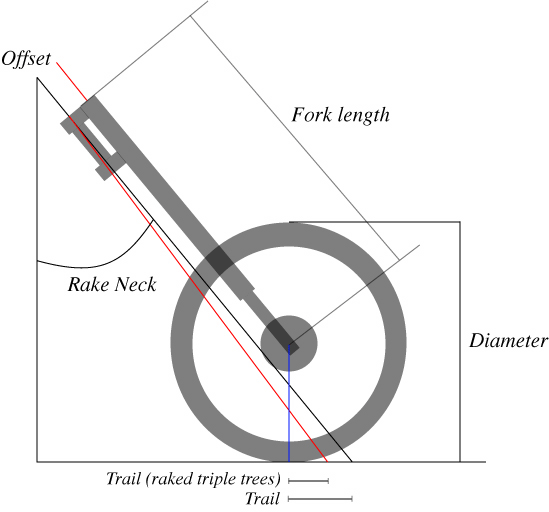I have the same Queen Mary turning radius because of the fairing. I actually added some metal to the steering head plate of the fairing bracket to restrict my yoke swing so I wouldn't crush my hands on the fairing. I wasn't going to bend over to use lower clip ons instead of handlebars, nor did I want to raise the fairing since it was too high to begin with...
My 70 model is 2.25" fork offset, 19" front wheel, 27 degree headstock angle ----- 104.648mm trail. - 4.12" trail
The 73 model 750 has a 2.81" offset, 19" front wheel, 27 degree headstock angle ---- 88.9mm of trail - 3.5" of trail
the 850 model has 2.81" offset, 19" front wheel, 28 degree headstock angle with a -1 degree yoke angle ---80.264mm of trail - 3.2" of trail
the 850 model has 2.81" offset, 19" front wheel, 28 degree headstock angle with a +1 degree yoke angle ---109.22mm of trail - 4.31" of trail
the 850 model has 2.81" offset, 19" front wheel, 28 degree headstock angle with a 0 degree yoke angle ---95.504mm of trail - 3.76" of trail
****************************************************************************************************************************************************
So, I see a real anomaly here in the math, so I tried the ANG rake number in both +1 and -1 directions, and also zero to see if any of them made sense.... but it doesn't actually
IF the 73 750 has 27 degree rake and the resulting trail is 3.5", It makes sense that the 73 850 with 28 degrees and no yoke rake would have a longer trail of 3.76". It would have .26" more and be more stable going straight as logic predicts
But, the 73 850 has the ANG yokes which have a -1 degree yoke rake along with the increased 28 degree headstock rake. That trail comes out to 3.2" which is less trail than the 73 750 trail of 3.5" so it should be less stable, but the change to the 850 was done to add stability. How is less trail going to make the 850 more stable???
I also computed the yoke rake as a +1 degree thinking that maybe I had the rake direction of the yoke incorrect. That trail comes out to 4.31" of trail which makes sense because it would be more stable than the 73 750 which is again 3.5" of trail,.... but the new wheel base would be longer with the + rake added and I was under the impression that the yoke rake was to shorten the wheel base after increasing the head stock angle,.... so the math of the +1 yoke rake makes sense that the bike would gain stability, but it doesnt fit with the narrative that the yoke rake was added to the 28 degree frame to maintain the shorter wheel base.... because that yoke rake would have to be negative 1, not positive 1
Anyone know how the 850 can have less trail than the 750 and claim to be more stable?.... Something isn't right or I have something backwards... Anyone?
here's the image to work out the visualization if anyone is interested.

